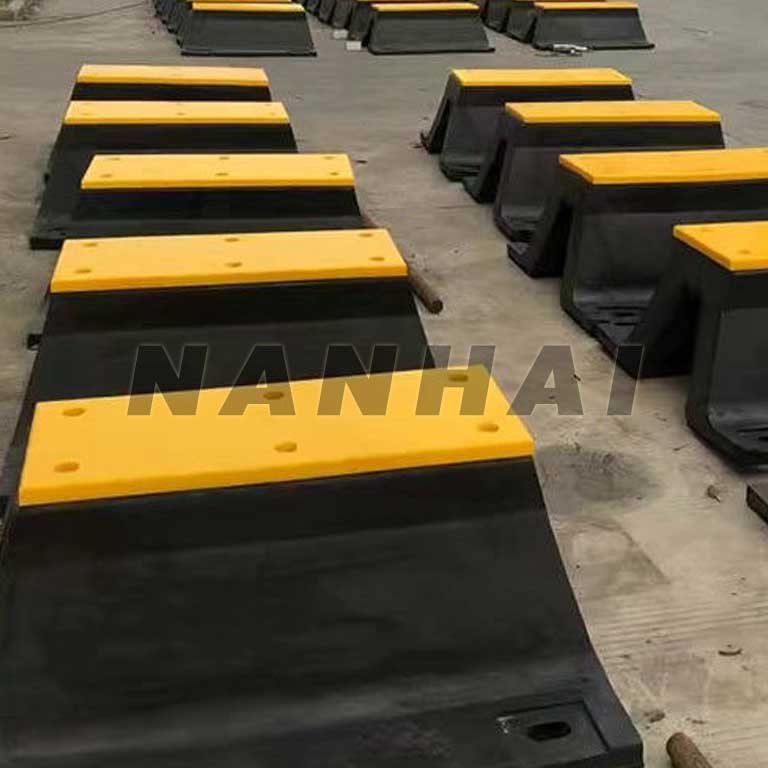Pourquoi les grands ports font-ils confiance aux défenses cellulaires pour l'accostage de charges lourdes? ?
07/09/2025Points clés des étapes de l'opération de réparation des airbags de lancement de navires
07/09/2025Pare-chocs extra-robustes pour les environnements difficiles
1. Introduction
Les ports, les terminaux de marchandises et les quais pour remorqueurs sont souvent soumis à des impacts violents de la part des navires. Ces endroits ont besoin de systèmes de défenses solides pour éviter les dommages. Garde-boue extra-robustes fonctionnent bien dans des environnements difficiles. Ils absorbent l'énergie et protègent les navires et les structures portuaires.
2. Qu'est-ce qu'une défense en arc de cercle ?
Les défenses en arc ont une forme incurvée, semblable à celle d'un pont. Cette conception leur permet de supporter des impacts importants tout en maintenant une faible force de réaction. Garde-boue en arc de cercle sont plus solides et plus durables que de nombreux autres types de défenses, comme les défenses cylindriques ou coniques. Elles supportent également mieux les forces de cisaillement, ce qui les rend idéales pour de nombreuses situations d'accostage.
-fenders-拷贝.webp)
3. Principales caractéristiques de la conception des défenses en arc robustes
3.1 Absorption d'énergie élevée
Les garde-boue en arc de cercle absorbent bien l'énergie de l'impact. Leur conception répartit la force et réduit les dommages.
3.2 Construction monobloc en caoutchouc
Ces ailes sont moulées en une seule unité. Elles sont solides, faciles à installer et à entretenir.
3.3 Grande résistance au cisaillement
Les défenses en arc résistent aux mouvements latéraux et aux forces de cisaillement. Cette caractéristique est importante pour les quais très fréquentés où les navires se déplacent lorsqu'ils sont amarrés.

4. Amélioration des matériaux et de la surface des défenses en arc de cercle
4.1 Coussinets de parement en UHMW-PE
Des tampons en UHMW-PE (polyéthylène à très haut poids moléculaire) sont ajoutés à l'avant de l'aile. Ces plaquettes résistent à l'usure, réduisent les frottements et durent plus longtemps.
4.2 Renforcement des plaques d'acier
Certaines défenses combinent l'UHMW-PE et des plaques d'acier. Cette configuration ajoute de la résistance et fonctionne bien sur les quais à forte charge.
4.3 Formules de caoutchouc de qualité supérieure
Les fabricants utilisent un caoutchouc qui résiste aux rayons UV, à l'eau salée et aux produits chimiques. Ces matériaux sont très performants dans les environnements marins.

5. Types de défenses en arc
| Type de garde-boue | Caractéristiques principales |
|---|---|
| Arceau standard | Pour une utilisation générale dans les quais de taille moyenne |
| Arceau avec face en UHMW-PE | Faible frottement et réduction de l'usure des navires |
| Arceau avec panneau en acier | Une structure plus solide pour les navires lourds |
| Garde-boue avec butoirs de surcharge | Protège le corps en caoutchouc contre les forces excessives |
6. Applications réelles des défenses en arc
- Terminaux à conteneurs et postes d'amarrage RoRo: Les défenses en arceau résistent aux impacts fréquents et protègent les structures des quais.
- Terminaux pour remorqueurs et barges: Les charges de cisaillement élevées nécessitent des ailes solides avec des surfaces résistantes à l'usure.
- Piliers de pont et quais flottants: Les défenses en arc préviennent les dommages causés par les collisions aux grandes structures maritimes.
7. Guide de sélection des fenders
- Énergie d'impact: Choisissez les défenses en fonction de la taille du navire et de la vitesse d'accostage.
- Résistance à l'environnement: Utiliser un caoutchouc qui résiste aux UV, au sel et à l'exposition aux produits chimiques.
- Limites de la force de réaction: Choisissez des défenses qui ne surchargent pas les coques des navires ou les murs des quais.
- Entretien et remplacement: Choisissez des garde-boue munis de patins d'usure remplaçables pour économiser sur les coûts à long terme.
8. Que se passe-t-il si vous utilisez le mauvais garde-boue ?
8.1 Dommages aux navires et aux structures
Si la défense ne peut pas absorber suffisamment d'énergie, le navire ou le quai peut subir des dommages. Il peut s'agir de coques fissurées, de pieux tordus ou de jetées cassées.
8.2 Risques pour la sécurité
Des défenses incorrectes ne peuvent pas empêcher les navires de dériver. Cela peut entraîner des accidents, des blessures ou la chute de la cargaison par-dessus bord.
8.3 Pollution et temps d'arrêt
Les dommages peuvent entraîner des fuites de pétrole ou de produits chimiques dans la mer. Les réparations prennent du temps et interrompent les activités du quai.
8.4 Coûts élevés et problèmes juridiques
Les ailes bon marché ou dépareillées s'usent rapidement. En cas d'accident, vous risquez de devoir faire face à de lourdes factures de réparation, voire à des poursuites judiciaires.
Conclusion : L'utilisation d'un mauvais garde-boue dans un environnement difficile constitue un risque sérieux. Les ailes en caoutchouc résistantes réduisent ces risques. Elles offrent sécurité, réduction des coûts et tranquillité d'esprit.
9. Conseils d'installation et d'entretien des défenses en arc
- Positionnement adéquat: Pour obtenir les meilleurs résultats, alignez le pare-battage sur la zone d'impact du navire.
- Inspections de routine: Vérifier le corps en caoutchouc, les boulons et les tampons d'appui tous les 6 mois.
- Nettoyage de surface: Éliminer le sel et les salissures marines. Utiliser des produits de protection contre les UV pour prolonger la durée de vie des ailes.
- Remplacer les pièces usées: Remplacer rapidement les plaquettes ou les caoutchoucs endommagés afin d'éviter les défaillances.
10. Réflexions finales
Les défenses en arceau robustes sont essentielles à la sécurité et à l'efficacité des opérations portuaires. Leur conception solide et leurs matériaux améliorés protègent les navires et les quais dans les conditions les plus difficiles. Le choix de la bonne défensive vous permet d'éviter les dommages, les retards et les coûts supplémentaires. Investir dans des défenses en arc de haute qualité est intelligent, sûr et durable.
